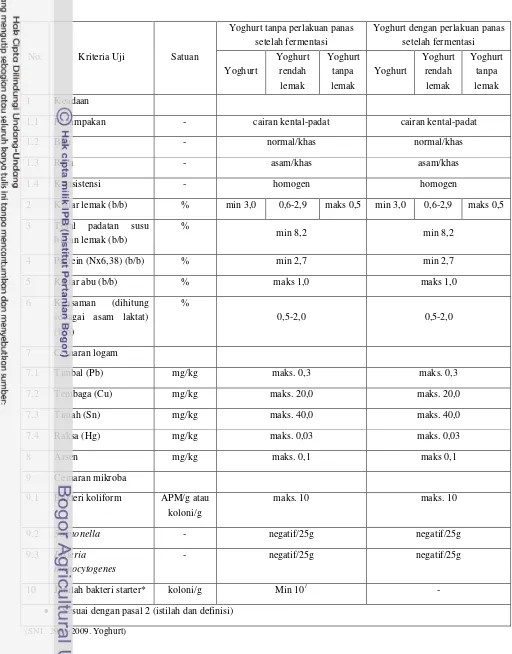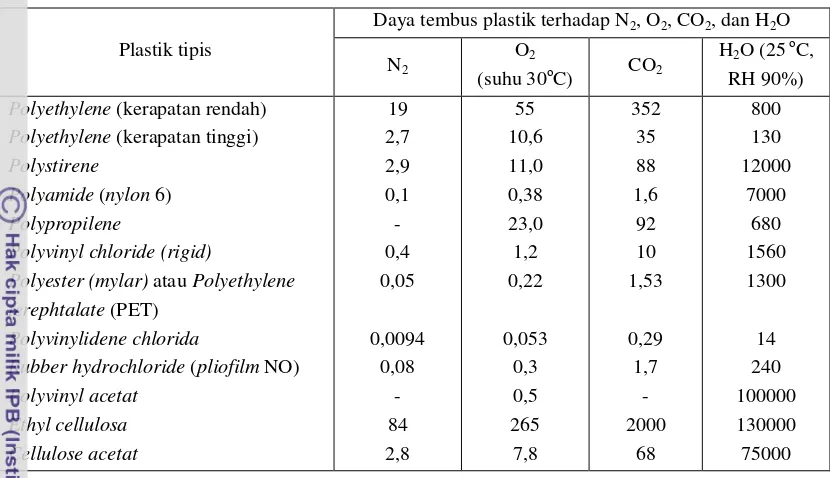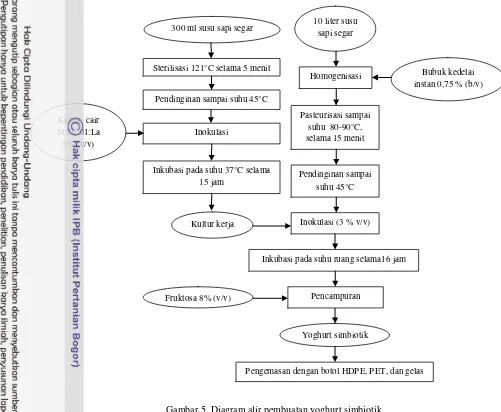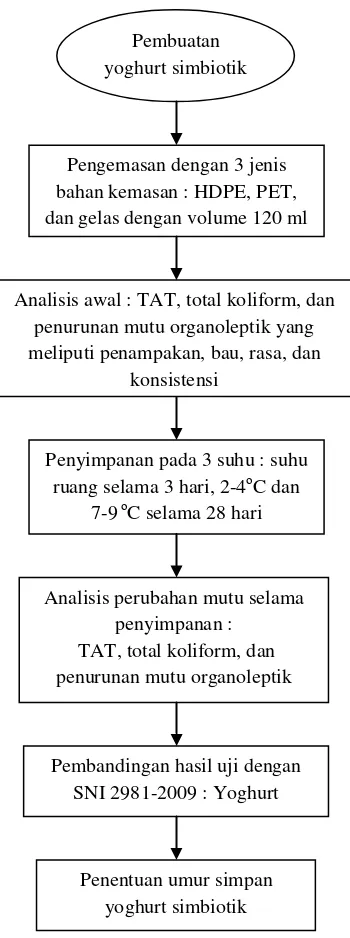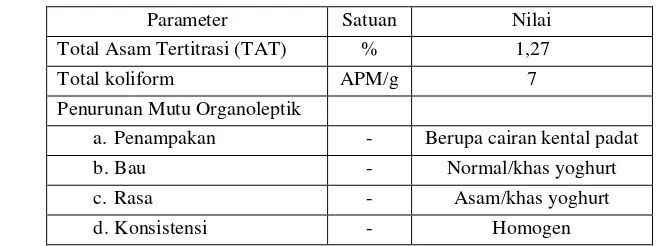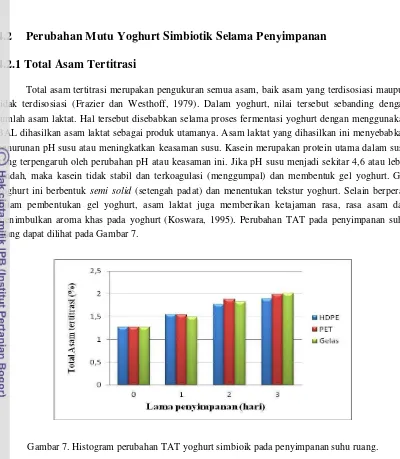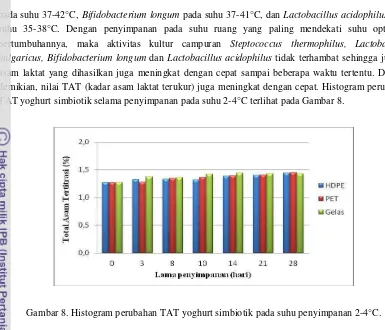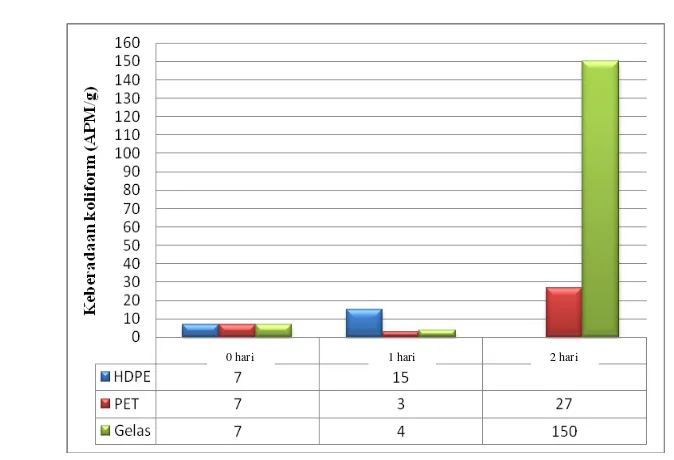Informasi Dokumen
- Penulis:
- Risa Asriyani
- Liesbetini Hartoto
- Erliza Hambali
- Pengajar:
- Liesbetini Hartoto
- Erliza Hambali
- Sekolah: Bogor Agricultural University
- Mata Pelajaran: Agroindustrial Technology
- Topik: Shelf Life of Symbiotic Yoghurt in Variety of Packaging Materials and Storage Temperatures
- Tipe: thesis
- Tahun: 2012
- Kota: Bogor
Ringkasan Dokumen
I. INTRODUCTION
The introduction provides a foundational understanding of symbiotic yoghurt, which is produced through the fermentation of milk using specific bacterial cultures. It highlights the nutritional superiority of yoghurt compared to fresh milk and emphasizes the importance of probiotics in maintaining gut health. The section outlines the rationale behind developing a symbiotic product that combines prebiotics from soybean flour with beneficial probiotic bacteria. This sets the stage for understanding the significance of shelf life in food products, particularly in the context of yoghurt, and the impact of packaging materials and storage conditions on product quality.
1.1 Background
This subsection delves into the history and nutritional benefits of yoghurt, explaining how it is made and the role of different bacterial cultures. It discusses the challenges faced by traditional yoghurt cultures in surviving the acidic environment of the digestive tract, leading to the development of probiotic yoghurt that includes strains like Lactobacillus acidophilus and Bifidobacterium longum. The section also introduces the concept of prebiotics and their role in enhancing the effectiveness of probiotics, thereby reinforcing the educational value of understanding food science.
1.2 Objectives
The objectives of the study are clearly outlined, focusing on assessing the quality changes in symbiotic yoghurt during storage and determining its shelf life based on varying packaging materials and storage temperatures. This section is crucial for students and researchers as it provides a clear research goal and emphasizes the importance of quality control in food products.
1.3 Scope
This subsection defines the scope of the research, specifying the types of bacteria used, the storage temperatures, and the packaging materials tested. By narrowing down the focus, it encourages a more in-depth study of specific variables affecting yoghurt quality, which is beneficial for academic inquiry and practical applications in food technology.
II. LITERATURE REVIEW
The literature review synthesizes existing research on various components relevant to the study, including fresh milk, soybeans, lactic acid bacteria, and the unique properties of symbiotic yoghurt. It discusses the nutritional composition of fresh milk and the significance of soy as a prebiotic source, providing a comprehensive background that supports the study's hypotheses. This section is vital for students to understand the foundational theories and principles that inform their research.
2.1 Fresh Milk
This subsection discusses the properties and nutritional composition of fresh milk, including its pH levels, protein content, and the impact of various factors on its quality. Understanding these properties is essential for students studying food science, as it lays the groundwork for comprehending how milk serves as a base for yoghurt production.
2.2 Soybeans
The nutritional benefits of soybeans are highlighted, emphasizing their role as a protein source and their content of oligosaccharides, which act as prebiotics. This knowledge is crucial for students in agroindustrial technology, as it connects plant-based sources to probiotic applications in food products.
2.3 Lactic Acid Bacteria
This subsection provides an overview of lactic acid bacteria, their classification, and their importance in food fermentation. It emphasizes the role of these bacteria in yoghurt production and their health benefits, which is essential knowledge for students interested in microbiology and food technology.
2.4 Symbiotic Yoghurt
The characteristics of symbiotic yoghurt are discussed, including its production process and health benefits. This section is valuable for students as it encapsulates the integration of probiotics and prebiotics, reinforcing the concept of functional foods in modern nutrition.
2.5 Storage Temperature
The ideal storage temperatures for yoghurt are outlined, along with their effects on product stability and shelf life. This information is critical for students studying food preservation techniques and the science behind food storage.
2.6 Viability of Lactic Acid Bacteria
This subsection discusses the viability of lactic acid bacteria during yoghurt storage, providing insights into how storage conditions affect bacterial populations. Understanding bacterial viability is crucial for students focusing on food safety and quality control.
2.7 Packaging
The importance of packaging in preserving food quality is explored, including the properties required for effective food packaging. This section is significant for students as it highlights the intersection of material science and food technology.
III. METHODOLOGY
The methodology section outlines the procedures followed in the research, including yoghurt production, storage conditions, and quality assessment methods. This section is essential for students as it provides a step-by-step guide to conducting similar research and emphasizes the importance of scientific rigor in experimental design.
3.1 Yoghurt Production
Details on the production process of symbiotic yoghurt, including the selection of bacterial cultures and the incorporation of prebiotic soy flour, are provided. This subsection is crucial for students to understand the practical aspects of food production and fermentation.
3.2 Storage Conditions
The various storage conditions, including room temperature and refrigeration, are described, along with their impact on yoghurt quality. This information is vital for students studying the effects of environmental factors on food products.
3.3 Quality Assessment
Methods for assessing yoghurt quality, including titratable acidity and organoleptic tests, are detailed. This section is important for students to learn about quality control measures in food science.
IV. RESULTS AND DISCUSSION
The results section presents the findings of the research, including the shelf life of symbiotic yoghurt under different conditions. The discussion interprets these results in the context of existing literature, emphasizing the implications for food technology and consumer health. This section is critical for students to develop analytical skills in interpreting research findings.
4.1 Shelf Life Determination
The findings regarding the shelf life of symbiotic yoghurt in various packaging and storage conditions are discussed. This information is essential for students to understand the practical applications of their research in the food industry.
4.2 Quality Changes
This subsection analyzes the quality changes observed during storage, including microbial growth and sensory attributes. Understanding these changes is crucial for students studying food preservation and safety.
4.3 Implications for Packaging
The implications of packaging material on yoghurt shelf life and quality are examined. This analysis is valuable for students as it links packaging technology with food science.
V. CONCLUSION
The conclusion summarizes the key findings and their significance for the food industry, particularly in developing healthier yoghurt products. It emphasizes the importance of understanding the interplay between packaging, storage conditions, and product quality. This section is vital for students to grasp the broader implications of their research.
5.1 Recommendations
Recommendations for future research and practical applications in the food industry are provided. This encourages students to think critically about the next steps in their research and the potential for innovation in food technology.
Referensi Dokumen
- Total Asam Tertitrasi ( AOAC, 1995 )
- Uji Keberadaan Koliform ( SNI-19-2897, 1992 )
- SNI 2981 ( 2009 )


